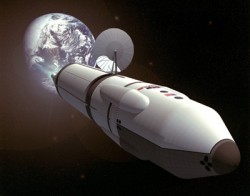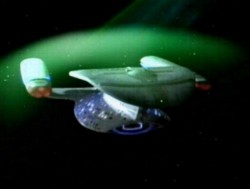[/caption]British scientists invent “mini-magnetosphere” to protect astronauts during solar storms.
Space travel during a solar storm just became a little less risky. UK scientists working at Rutherford Appleton Laboratory near Oxford and the universities of York and Strathclyde have tested a “mini-magnetosphere” enveloping a model spacecraft in the lab. It turns out that their prototype offers almost total protection against high energy solar particles. By mimicking the natural protective environment of the Earth, the researchers have scaled the protective magnetic bubble down into an energy efficient, yet powerful deflector shield.
This astounding achievement is a big step toward protecting sensitive electronics and the delicate human body against the radioactive effects of manned missions between the planets. It may sound like science fiction, but future astronauts may well shout the order to “RAISE SHIELDS!” if the Sun flares up during a 36 million mile journey to Mars…

Not so fast. The biggest drawback I could see back in January was the large amount of energy that would be required to power the system. After all, to generate a stable, spaceship-sized mini-magnetosphere would need a vast quantity of electricity (and be very bulky), or it would need to be highly efficient (and compact). As this is space travel we’re talking about, the scientists would need to look into the latter. The mini-magnetosphere would need to be a highly efficient device.

“These initial experiments have shown promise and that it may be possible to shield astronauts from deadly space weather,” Dr Bamford said. After all, the effects of radiation poisoning can be devastating.
Prof. Bob Bingham, a theoretical physicist at the University of Strathclyde, gives a graphic account as to why this technology is important:
“Solar storms or winds are one of the greatest dangers of deep space travel. If you got hit by one not only would it take out the electronics of a ship but the astronauts would soon take on the appearance of an overcooked pizza. It would be a bit like being near the Hiroshima blast. Your skin would blister, hair and teeth fall out and before long your internal organs would fail. It is not a very nice way to go. This system creates a Magnetic Field Bubble that would deflect the dangerous radiation away from the spacecraft.” – Prof. Bob Bingham
Bingham added that the team was currently patenting the technology and hopes to have a working full size prototype within five years. So we might have to wait some time until we see some pictures of the system in action…
Source: Telegraph (UK)


Very cool.
Hmm, deflect radiation. Maybe energy shields that can protect against a nuclear blast are no longer pure scifi but theoretically possible. Whoever gets this first will win a global thermonuclear war, no more tic-tac-toe
I’m sure they’re only talking about charged particles here (which would already be a huge step forward). Gamma rays or neutral particles can’t be deflected by magnetic fields.
I wonder if this technology could also be adapted for use in experimental Nuclear Fusion power stations to shield the chamber walls against corrosion. That would make them commercially viable, for a change.
@Mark
This is what is in use for nuclear fusion reactors ( super conductors magnets)
@mrt181
this is only for charged particles Gamma rays and neutral particles cannot only be absorbed by a the spaceship structure.
@Kurt:- While this isn’t the silver bullet that will protect astronauts 100%, it does cancel out the significant risk of high-energy (charged) particles. As the majority of solar wind particles are high energy protons, this is a good answer. As for X-ray and gamma radiation, there will still need to be a “safe zone” inside the spacecraft with a protective hull – although damaging EM radiation will hit you without warning. I think we have a while to go before we start manufacturing the first USS Enterprise…
Cheers 🙂
Ian
now all we need is a spacecraft that’s worth a s***. NASA? anyone?
Is there any potential application for orbiting (unmanned) satellites to protect them from solar flares?
I’ve been hoping for something like this for a long time, and I knew it was feasible.
This is very exciting.
While the article does mention the similarity in the effects of a solar event and nuclear radiation on a human, they have vastly different causes. No sort of electromagnetic shielding can keep out nuclear radiation simply because of the fact that neutron particle radiation has no electromagnetic charge. It passes through a magnetic field like it’s not there.
So while this is an exciting discovery, it has no effect in a traditional nuclear/radiological environment.
“they have devised a system no bigger than a large desk that uses the same energy as an electric kettle.”
Future British astronauts will now be faced with a terrible dilemma… raise the shields or plug in the kettle for a cuppa. That’ll be a tough call!
“they have devised a system no bigger than a large desk”
How large a desk are we talking here?
cool. i can imagine this being used for moon stations as well.
Good work… and me thinks they’ll have a long time to perfect the technology before we start sending people into interplanetary space… Similar technology could also be highly useful for permanent moon bases and the like too.
This makes me very happy, Mars, though still an extremely difficult challenge, is starting to look human doable again.
Cheers guys, you have made me dream again!
I suspect the radiation challenge will be fairly easy to deal with. The real problem, as I see it, will be to protect the space vehicle from destruction running into unknown space debris. For example, I don’t believe there is any way to avoid destruction traveling ten or more miles per second running into a baseball size chunk of something solid.
What funds do Dr Bamford and the Rutherford Appleton Laboratory have? Having a working full size prototype within five years is too late. I guess that NASA’s Orion crew exploration vehicle would need partial redesign to integrate the shield device. And in five years it would presumably be too late for changes. The speed of realisation depends on money. Public money is devoured by the fight against the impact of the financial crisis. And due to the disastrous financial situation of research in Britain I wonder that they made it so far at all.
Presumably, we will have to wait for many years before we will see real progress. The war chests of science are empty. And then there is always a lobby who claims the money for something else.
I think 5 years is quite feasible, at least it will be tested and optimised rather than being rushed. It’d be cool if we could have a planetary shield for Earth!
Here in Britain ‘big science’ has always been a long way behind other countries and science like this is right at the back of the queue. It’s usually down to the ingenuity of the scientists concerned that gets it done. Even though Beagle 2 ultimately failed, because the project was done on a shoestring, the team strove like heroes to get it to Mars. The problem in Britain lies with the fact that government departments are usually run by ministers who have either no interest in the portfolio or they have no qualifications or experience in the ministry. We’ve had people with degrees in classics/English running the science department; historians running the economy; economists running education etc. etc. No wonder we’re now a third world country.
Won’t the magnetic field adversly effect electronic and other equipment on board ship?
>historians running the economy;
Surely this is a very good idea?!
If only financial policy makers could look a bit further back than the last quarter they might be able to avoid such huge disasters.
They only had to search wikipedia for “Savings and Loans scandal”, an event which occurred less than twenty years ago to avoid this whole mess.
Ben
Sakib,
We HAVE a particle shield around Earth, how do you think life has survived here so long?
And Chuck, there really aren’t a lot of space rocks etc out there. That’s why they call it a vacuum in space. There’s nothing there. Think about our satellites and robot probes, none have been hit by anything bigger than dust! I think this is a HUGE step forward! If you can live within the shield, and work electronic equipment then we have the first working part of the first Starship!
To Peter, I’m thinking that the ‘lost contact’ with several probes over the years could easily be the result of destruction running into space debris rather than failure of communication electronics. It would be challenging to prove or disprove the possibility of space debris induced vehicle destruction. Or, for that matter, the statistical odds for such an event. I don’t believe space is as empty as we think it is. Space debris may be an insurmountable barrier to space travel.
Although this research isn’t generally known to the public, it describes, in part, a non-rocket approach to the Magnetic Ion type shield.
http://community-2.webtv.net/SkyVessel-1/doc0/
As you can see, there are many more advantages to this approach.
Prime
;))) oh my goodness ;))) amusing
thanks
just another crazy idea
would it be useful to upgrade the ISS with a Bamford small-scale magnetosphere generator? The ISS then possibly could orbit earth in a much higher orbit, because the crew’s health would no longer depend on the protecting earth magnetosphere. Thus, the atmospheric drag of low orbit could be avoided.
What side effects could such a magnetosphere have to the station’s system?
They should make a very large solar-powered version of these. Put one at EM L1 and the other at EM L2 to shield a future moon base.
Wow, this is really amazing!
I bet there going to use this for SPACE COMBAT!!!!!
😀
i got you a tips for spare on energy to the spaceship the atmosfer of mars is big and the thing i wana say is you can get the energi from the atmosfer off mars but its will be a problem when you coming upp agen from the atmosfer